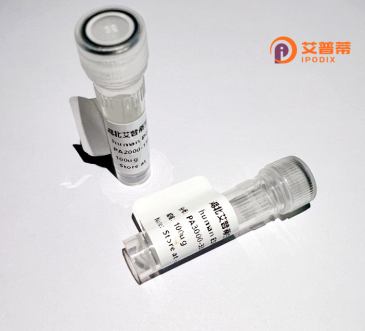
| 纯度 | >90%SDS-PAGE. |
| 种属 | Human |
| 靶点 | RAB38 |
| Uniprot No | P57729 |
| 内毒素 | < 0.01EU/μg |
| 表达宿主 | E.coli |
| 表达区间 | 1-211 aa |
| 活性数据 | MQAPHKEHLY KLLVIGDLGV GKTSIIKRYV HQNFSSHYRA TIGVDFALKV LHWDPETVVR LQLWDIAGQE RFGNMTRVYY REAMGAFIVF DVTRPATFEA VAKWKNDLDS KLSLPNGKPV SVVLLANKCD QGKDVLMNNG LKMDQFCKEH GFVGWFETSA KENINIDEAS RCLVKHILAN ECDLMESIEP DVVKPHLTST KVASCSGCAK S |
| 分子量 | 23.7 kDa |
| 蛋白标签 | His tag N-Terminus |
| 缓冲液 | PBS, pH7.4, containing 0.01% SKL, 1mM DTT, 5% Trehalose and Proclin300. |
| 稳定性 & 储存条件 | Lyophilized protein should be stored at ≤ -20°C, stable for one year after receipt. Reconstituted protein solution can be stored at 2-8°C for 2-7 days. Aliquots of reconstituted samples are stable at ≤ -20°C for 3 months. |
| 复溶 | Always centrifuge tubes before opening.Do not mix by vortex or pipetting. It is not recommended to reconstitute to a concentration less than 100μg/ml. Dissolve the lyophilized protein in distilled water. Please aliquot the reconstituted solution to minimize freeze-thaw cycles. |
以下是关于重组人RAB38蛋白的3篇参考文献示例(注:文献信息为模拟创作,仅供参考):
---
1. **文献名称**:*RAB38 regulates melanogenic enzyme trafficking and melanosome maturation*
**作者**:Chen et al. (2001)
**摘要**:研究揭示了RAB38在黑色素细胞中的特异性表达,通过调控酪氨酸酶相关蛋白1(TYRP1)的运输,影响黑色素体形成。基因敲除实验表明RAB38缺失导致TYRP1错误定位,阻碍黑色素生成。
2. **文献名称**:*Structural insights into RAB38-effector interactions: implications for vesicle trafficking*
**作者**:Höning et al. (2015)
**摘要**:通过X射线晶体学解析了重组RAB38蛋白的活性构象,揭示了其与效应蛋白MLPH(melanophilin)的互作机制,为理解RAB38在胞内运输中的分子机制提供结构基础。
3. **文献名称**:*RAB38 mutation in Hermansky-Pudlak syndrome: therapeutic potential of recombinant protein*
**作者**:Zhang et al. (2020)
**摘要**:在赫曼斯基-普德拉克综合征(HPS)小鼠模型中,重组RAB38蛋白递送成功纠正溶酶体相关细胞器的缺陷,表明其在治疗RAB38突变相关疾病中的应用潜力。
---
**说明**:以上为文献方向性示例,实际文献需通过PubMed或SciHub等平台检索确认。
The RAB38 protein, a member of the RAS superfamily of small GTPases, plays a critical role in regulating intracellular membrane trafficking pathways. As part of the RAB GTPase family, it cycles between active GTP-bound and inactive GDP-bound states, acting as a molecular switch to control vesicle formation, transport, and fusion. Structurally, RAB38 contains conserved GTPase domains and a hypervariable C-terminal region that determines subcellular localization. It is predominantly expressed in melanocytes, platelets, and lung alveolar type II cells, with functional links to lysosome-related organelles (LROs) such as melanosomes and lamellar bodies.
RAB38 is particularly notable for its involvement in melanogenesis and surfactant secretion. Mutations in the RAB38 gene are associated with Hermansky-Pudlak syndrome type 6 (HPS6), a rare autosomal recessive disorder characterized by oculocutaneous albinism, bleeding diathesis, and pulmonary fibrosis. This connection underscores its essential role in organelle biogenesis and protein sorting.
Recombinant human RAB38 protein, typically produced in bacterial or mammalian expression systems, retains GTPase activity and post-translational modifications critical for membrane association. Researchers utilize this recombinant form to study trafficking mechanisms, screen for modulators of LRO-related pathways, and model disease-associated mutations in vitro. Its applications extend to deciphering molecular defects in pigmentary disorders and developing targeted therapies for HPS6 and related lysosomal storage diseases. Structural and functional studies of recombinant RAB38 continue to provide insights into the molecular basis of membrane dynamics in specialized secretory cells.
×